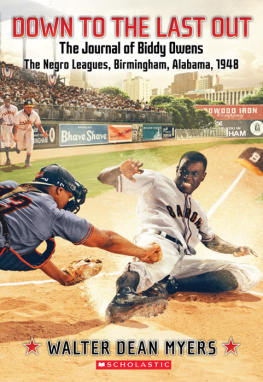Contents



1983 by Donn Rogosin
Introduction 2020 by Donn Rogosin
Originally published by Atheneum in 1983
Appendixes are reprinted from Only the Ball Was White
by Robert Peterson, published by Prentice-Hall, Inc.
Copyright 1970 by Robert Peterson; used by permission of the author.
All rights reserved
First Nebraska paperback printing: 2007
Library of Congress Control Number: 2020938592
The publisher does not have any control over and does not assume any responsibility for author or third-party websites or their content.

Foreword
I first met Donn Rogosin when he was a young, dynamic professor of American Studies at the University of Texas. I was very impressed with his knowledge of the Negro leagues, but it was his close contact with Willie Wells, my manager when I was with Newark in the Negro leagues and my dear friend, that made our relationship. Not only was Willie Wells a truly great player and one of the smartest baseball men who ever lived, but his career went back to nearly the beginning of the Negro leagues, and I knew right away that Donn would have access to the whole story.
Over the years with my help and the help of other fellows, Donn went around the country meeting the old Negro leaguers and interviewing them in their homes. The time was right. Donn had a chance to talk with Satchel, Cool (Papa Bell), Judy (Johnson), Buck (Leonard), and the rest. If he had not had this opportunity, their stories would have been lost.
Much hard work went into this projectboth time and energy. Donn has attempted to tell the story of the Negro leagues the way it should be told. He gained a complete prospective by talking to managers, owners, and players. He did an in-depth study and was very thorough. He had adventures on the road, and he interviewed in some pretty tough parts of this country. Sometimes the fellows would keep up with each other through Donn.
At the time we played in the Negro leagues we were young and we had talent. Negro baseball was very important to us, but it was not important to the other segments of American lifeby that I mean white people. We were saying, Hey, notice us. Now it has become important, and the establishment wants to make amends.
Invisible Men is really much more than a book about sports. I am happy to be in it and to have helped with it. For many of us who played Negro league baseball, this is a book we have long awaited.
M ONTE I RVIN
Preface
This book began in Willie Wellss living room, where I first heard the tales of the Negro leagues and learned of segregated baseball. My initial visit to Wellss home was innocent enough. At the time, I was teaching American Studies at the University of Texas and was seeking someone or something that might shake the lethargy which permeated my classes. I felt that maybe a Negro league baseball player discussing segregated baseball could bring home the essence of segregation to students seemingly so insulated from Americas past history of racial injustice. So I went to see Wells, to check him out and to discover if he would work as a classroom speaker.
I came away from our meeting stunned. I was amazed by his stories and profoundly moved by his spirit and dignity. Needless to say, he was most effective in the classroom.
But I also had found a friend. Many times during the summer of 1977, I returned to visit with Willie Wells. Usually we would listen to ball games on the radio and he would patiently answer questions about Satchel Paige, Josh Gibson, Oscar Charleston, and the other great ballplayers he had known. (He almost never spoke of himself and I had to get my Willie Wells stories later from his teammates.)
After a while I began to tape our meetings. Then I asked National Public Radio if they would back a documentary series based upon the oral histories of as many Negro leaguers as I could find. They agreed. And so, with a borrowed tape recorder and instructions in the rudiments of radio production, I set out after Negro leaguers. It was a joyous task and one that got easier as one player led to the next, and each impression contributed to a more complete picture.
The completed documentaries were broadcast by National Public Radio first in 1980. I shall always feel grateful for NPR and KUT-FM in Austin, Texas, for making my work on Negro league baseball possible. I remain especially indebted to Bill Grimes, a radio producer and editor of skill and integrity. James Earl Joness willingness to narrate that series for me was a kind act by a most decent and wonderful man.
Once Negro league baseball had become my passion, I was pleased to find that, without exception, those who had been touched by the Negro leaguers were eager to assist me. Robert Peterson and John Holway, the men who first wrote about the Negro leagues for white audiences, were always helpful. While Invisible Men contains my own deeply felt view of the Negro leagues, it is no secret that I follow a path that these men first marked out.
I was fortunate that the Smithsonian Institution asked me to help mount a special exhibit on the Negro leagues for display in April of 1981. Working with curator Carl Scheele, Ellen Rooney Hughes, and Jim Piper of the National Museum of American History was an education and a pleasure. It also added a dimension to my work by exposing me to the sensitive perceptions of the best museum people in the world.
In 1979 in the midst of my researches, the Negro league reunions began in Ashland, Kentucky, and with them the push to build a Black baseball Hall of History. Without Nancy Dickinson and Harry Wiley of the Greater Ashland Foundation, the reunions could not have happened and without the reunions, this book would be a lesser effort. I have the deepest affection for Nancy and Gene Dickinson, Lisa Ma-hood, and Harry Wylie of Ashland, Kentucky; they have done much to preserve the story of the Negro leagues. Ashland Oil Company and Schlitz Brewing Company generously gave corporate funds to make the reunions possible.
Finally, of overwhelming importance to my work were my relationships with Craig Davidson, Scott McPherson, and Steve Schwartz. Craig Davidson had embarked on a project similar to mineto capture the texture of the Negro leagues and their glorious history. Only, Craig is a talented film maker and, unfortunately, film costs much more than audio tape or pencils. For years Craig plowed his time and money into his film. We became dear friends on the road. I was invited to join Refocus Productions, and we shared everything. Many things in this book are a result of our long and productive collaboration.
Of course, my largest debt is to the Negro leaguers themselves. They gave everything they had, generously and warmly. Of particular assistance to me were: Newt Allen, Dave Barnhill, Pepper Bassett, Cool Papa Bell, Gene Benson, Willard Brown, Roy Campanella, Jimmie Crutchfield, Ray Dandridge, Leon Day, Rudolpho Fernandez, Wilmur Fields, Bill Harvy, Buster Haywood, Sammy T. Hughes, Connie Johnson, Judy Johnson, Monte Irvin, Walter Buck Leonard, Webster McDonald, Jack Marshall, Minnie Minoso, John Buck ONeil, Ted Page, Satchel Paige, Pat Patterson, Andy Porter, Ted Radcliffe, Chico Renfroe, Dick Seay, Harry Solomon, Hilton Smith, Theolic Smith, Paul Stevens, Sam Streeter, Quincy Trouppe, and Willie Wells. In addition, Ric Roberts, Art Carter, and Sam Lacy, talented sportswriters of the Black newspapers, provided further information. Dorothy Harris, Effa Manley, and Lahoma Paige added their perceptions of Negro baseball, and they were close enough to it to know what was really going on.














